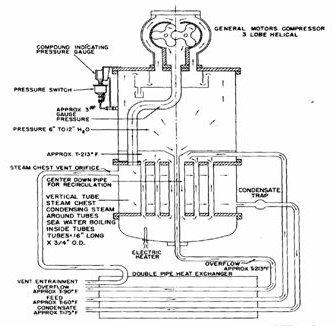Vapor Compression Distillation - Fresh Water Generator Working on Vapor Compression Principle
Vapor Compression Distillation
We have been learning about fresh water generators and the procedure to operate such an FWG. In this type of Fresh Water Generators, the evaporation takes place at positive pressure, slightly above atmospheric pressure. The vapor formed is compressed further to less than ONE bar in a lobe type Vapor Compressor in order to prevent it from condensing back to liquid state. This compressed vapor is used as heat source to heat and evaporate the seawater. Thus steam generated due to evaporation of seawater itself is used as the heat source and, the overall energy requirement for fresh water generation is negligible. These evaporators are used where source of heat i.e. steam, hot water etc. required to evaporate seawater is not available.
Operation of Fresh Water Generator
Theoretically, one kg of steam evaporates one kg of water. As the steam generated is used as the source of heat, the quantity of steam remaining in the system is constant. In other words, the quantity of steam generated due to boiling seawater equals the heating steam condensed. Only energy consumed is that used to operate the lobe type compressor. Condensate from the heating steam is collected as fresh water generated. There is no separate condenser in the system. The inflow of seawater to the evaporator is adjusted to control the rate of evaporation. Condensate removal is controlled and the level fresh water is maintained in the heat exchanger.
Evaporator Construction
The evaporator consists of a shell with Heat Exchanger at lower part as shown in the sketch. It is filled up with seawater to the required level maintained by funnel like structure in the center. Heating steam comes from the water evaporated which is compressed before sending it to Heat Exchanger. The lobe type compressor takes suction from the vapor generated and discharges to the Heat Exchanger. A demister is fitted before the compressor suction to prevent any water particles from entering compressor.
The heating steam gets condensed to fresh water and the condensate is collected as fresh water produced. Condensate level controls the condensate pump operation.
Seawater entering the evaporator as feed is preheated by the brine drained from the evaporator, the condensate as well as excess steam from evaporator.
The pressure maintained in the evaporator is slightly above the atmospheric pressure. If the pressure increases above a set value, it automatically releases some of the steam from evaporator and or it increases the feed rate.
For starting the evaporator from cold, electrical heating elements are provided at bottom of the evaporator to heat the seawater for evaporation. When sufficient steam is formed to sustain the evaporation rate, the electrical heating elements switch off automatically.
This type of evaporator consumes very less energy.
